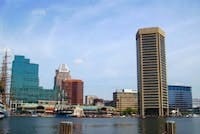The U.S. Environmental Protection Agency (EPA) and the state of Maryland announced a new set of pollution limits for trash for portions of the Patapsco River. These limits, also known as a total maximum daily load or TMDL, require the control of trash entering the tidal shoreline of the Middle Branch and Northwest Branch of the Patapsco River, including Baltimore Harbor and the upstream watersheds of Jones Falls and Gwynns Falls.
Each year, hundreds of tons of trash and debris are washed into the Patapsco watershed from storm water runoff, or dumped, not only creating a nuisance and an eyesore, but endangering birds, fish and other wildlife that ingest or become entangled in the debris.
The federal Clean Water Act directs states to develop TMDLs for impaired water bodies, such as the Patapsco River. A TMDL establishes the amount of a pollutant, in this case trash, that a water body can assimilate without exceeding water quality standards. TMDLs provide the basis for establishing water quality-based controls, reducing pollution from both point and nonpoint sources and restoring the quality of water resources.
“EPA applauds Maryland’s action to address the trash pollution problems in the Patapsco,” said EPA Regional Administrator Shawn M. Garvin. “TMDLs are an effective weapon in the fight for fishable, swimmable waters for all, as envisioned in the Clean Water Act.”
“As a life-long resident of Baltimore, I am very pleased with and proud of the work done by MDE’s Science Services Administration, in cooperation with the Baltimore City Department of Public Works, to take this important regulatory action,” said Maryland Department of Environment Secretary Robert M. Summers. “With the ongoing rejuvenation of the waterfront around Baltimore Harbor and the Patapsco River, a growing number of Marylanders and tourists are enjoying our waterways every year, and this TMDL for trash and the cleanup actions the city will take as a result are a big step forward for residents, visitors, water quality and the environment.”
In 2008, Maryland included portions of the tidal Patapsco River shorelines on its list of impaired waters due to excessive quantities of trash and debris. To complement this TMDL, the Maryland Department of the Environment is implementing the limits of these TMDLs through recently issued storm water permits to local governments that will include trash collecting in the waterbody as well as reducing trash dumping at the source.
The Maryland Department of Environment along with members of several non-governmental organizations have worked collaboratively with EPA in the completion of this series of trash TMDLs.
Source: EPA


